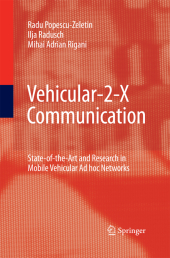 Neuerscheinungen 2014Stand: 2020-02-01 |
Schnellsuche
ISBN/Stichwort/Autor
|
Herderstraße 10
10625 Berlin
Tel.: 030 315 714 16
Fax 030 315 714 14
info@buchspektrum.de |

Radu Popescu-Zeletin, Ilja Radusch, Mihai Adrian Rigani
(Beteiligte)
Vehicular-2-X Communication
State-of-the-Art and Research in Mobile Vehicular Ad hoc Networks
2010. 2014. vi, 112 S. 9 Tabellen. 235 mm
Verlag/Jahr: SPRINGER, BERLIN; SPRINGER BERLIN HEIDELBERG 2014
ISBN: 3-642-42605-0 (3642426050)
Neue ISBN: 978-3-642-42605-6 (9783642426056)
Preis und Lieferzeit: Bitte klicken
This book describes concepts and technologies being developed for the European Car-to-Car Communication Consortium in relation with American Vehicle Safety Communication project, and shows how they will be used for application, traffic and network simulation.
Universal vehicular communication promises many improvements in terms of ac- dent avoidance and mitigation, better utilization of roads and resources such as time and fuel, and new opportunities for infotainment applications. However, before widespread acceptance, vehicular communication must meet challenges comparable to the trouble and disbelief that accompanied the introduction of traf c lights back then. The rst traf c light was installed in 1868 in London to signal railway, but only later, in 1912, was invented the rst red-green electric traf c light. And roughly 50 years after the rst traf c light, in 1920, the rst four-way traf c signal comparable to our today´s traf c lights was introduced. The introduction of traf c signals was necessary after automobiles soon became prevalent once the rst car in history, actually a wooden motorcycle, was constructed in 1885. Soon, the scene became complicated, requiring the introduction of the "right-of-way" philosophy and later on the very rst traf c light. In the same way the traf c light was a necessary mean to regulate the beginning of the automotive life and to protect drivers, passengers, as well as pedestrians and other inhabitants of the road infrastructure, vehicular communication is necessary to accommodate the further growth of traf c volume and to signi cantly reduce the number of accidents.
Applications of Vehicular Communication.- Communication Regimes.- Information in the Vehicular Network.- Routing.- Medium Access for Vehicular Communications.- Physical Layer Technologies.- Security.
Aus den Rezensionen:
"... bieten Experten von Fraunhofer FOKUS und der TU Berlin erstmals einen umfassenden Überblick über den aktuellen Forschungs und Technologiestand im Bereich Fahrzeug zu Fahrzeug und Fahrzeug zu Infrastruktur Kommunikation. ... stellt Kommunikations systeme und Anwendungen vor ... präsentiert Forschungsansätze und Simulationsmodelle, die Verkehrs leitsysteme verbessern, Unfälle vermelden und das Reisen komfortabler gestalten können." (Radu Popescu Zeletin, in: TU intern, January/2011, Issue 1, S. 6)


